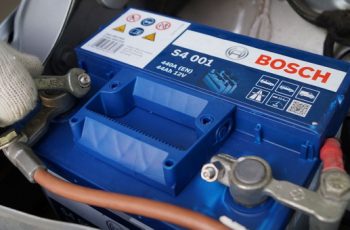Reconditioning batteries: What it is actually? Here’s the short description: Each battery that is supplied along with a product, be it vehicle, laptop, phone or any other electronic accessory, is bound to have a certain usable life.
It is different for different type of batteries, like 400-600 charge cycles of laptop and around 60 months(if you maintain your car properly) for a vehicle battery. After such time, battery performance starts to go down and ultimately battery dies. But is this really an end of that battery? No, not always.
Battery dies because of many factors. Like lack of regular maintenance, overcharging, or sulfation. While the first two factors are important for long life of battery, sulfation is natural to nearly all lead-acid batteries. In lead-acid batteries, electricity is produced when lead and lead dioxide present on battery plates, react with sulfuric acid to form lead-sulfate.
This lead-sulfate breaks down back into lead, lead dioxide and sulfuric acid, when battery is recharged. Sulfation is crystallization of lead sulfate. In simple terms, it means that over time life span of battery, this breaking of lead-sulfate leaves behind residue in form of crystals which stick to the plate and prevent recharging on battery. Sulfation is what is considered to be normal cause of battery dying. And here is where, reconditioning batteries as technique comes into the picture.
Reconditioning the old battery is way to reviving the battery using certain easy to do steps. They don’t require much effort on your part too. Now that you have a basic understanding of how a battery looses its recharging capacity and ultimately dies, you can use these steps to recondition your old battery.
Apart from saving you money that you will have to spend on new battery, you are also part of saving the environment which happens when old battery is dumped. Does reconditioning batteries work on all batteries? It is mostly yes. It does work on most of batteries. As we just read, there are many factors which lead to battery dying.
Reconditioning batteries involve following step wise approach to find out the reasons and take measures to reverse it Is it difficult? No, not at all!
Reconditioning batteries requires distilled water, rubber gloves, multimeter and charger. And of course your time 🙂 But reconditioning batteries is expensive? Not at all! That’s the whole point. You see, except for small amount you spend on distilled water or one time expense of multimeter and charger, you don’t have any other expense.
Plus these things combined cost a lot less than buying a new battery. Plus they are reusable each time you recondition a battery. Does reconditioning batteries require knowledge of electronics? Nothing except basic knowledge of positive and negative terminal 🙂 You are not supposed to open up the battery and work on inside material.
Reconditioning requires easy to do, simple and clear steps and nothing more than general understanding of electronic items is expected.
Reconditioning Batteries with Epsom Salt
 Don’t want to waste your time buying a new car battery? What if I told you there is a simple step by step process that you can make at home and save your battery? Sounds good? Then keep reading for information on reconditioning batteries with Epsom salt. And you probably already have what it takes.
Don’t want to waste your time buying a new car battery? What if I told you there is a simple step by step process that you can make at home and save your battery? Sounds good? Then keep reading for information on reconditioning batteries with Epsom salt. And you probably already have what it takes.
What is Epsom Salt? Epsom Salt is not really a salt, it is actually magnesium sulfate, which is a pure mineral. It has dozens of benefits, including battery reconditioning.
The benefits of Epsom salt ( magnesium sulfate) on batteries. Adding Epson salt together with distilled water and baking soda will help to dissolve the lead sulfate buildup and improve the battery.
How to Recondition the Battery using Epsom Salt
Things you’ll need: Baking soda, a gallon of distilled water, gloves, a bucket, multimeter & battery charger. Just follow the simple, and easy steps below:
- Clean the battery. This can be done with sandpaper.
- Remove the battery cell caps Make sure you use gloves because the acid might get on your skin and it’s not going to be pleasant.
- Dump the acid that’s in the battery in a bucket. Use long sleeves.
- Get 10 ounces of baking soda, mix it up with about one gallon of distilled water, do it in small amounts and stir it until it dissolves into the water.
- Start pouring it in and fill every cell. Do this very slowly and carefully. Put the cell caps back on and shake the battery for about 30 seconds ( the baking soda helps clean the inside of the battery)
- Remove the cell caps again and duck the solution into a bucket.
- Now mix about 15 ounces of Epsom salt with about one gallon of distilled water. Make sure you heat the water so you can mix it up a lot easier.
- Now fill up every cell with the distilled water and Epson salt solution.
- It’s time to grab the charger and slow charge the battery for about 24 hours on the low charging setting. Don’t put the cap on this time, sometimes the solution overflows. For safety purposes keep the battery on the floor.
- After 24 hours use your multimeter to check the voltage. If you still think it hasn’t improved very much, then put it back on the charger. If you’ve had any overflow issues, it is important that you add more solution. Put it on the 2amp setting and wait for another 24 hours.
Do’s and Dont’s
– Do it in a well-ventilated area
– Do use long sleeves and gloves
– Don’t add the Epsom salt straight into the battery, without first mixing it up with distilled water.
Troubleshooting
Be patient. The whole process can take up to 36 hours, and the results may not be immediate. Try changing the charger to make sure the problem is not with the charger. This process works best with older batteries. So there you have it, a step by step guide to reconditioning batteries with Epsom salt.
Reconditioning lead acid batteries
 Lead acid batteries are oldest low cost rechargeable batteries which being tolerant, robust, and affordable they are widely used for automotive. Larger batteries are used for storage in backup power supplies in cell phone towers, hospitals and stand alone power systems. They are huge and heavy and have a shorter life cycle. They suffer from infirmities like corrosion, shedding, internal short, sulfation, etc.
Lead acid batteries are oldest low cost rechargeable batteries which being tolerant, robust, and affordable they are widely used for automotive. Larger batteries are used for storage in backup power supplies in cell phone towers, hospitals and stand alone power systems. They are huge and heavy and have a shorter life cycle. They suffer from infirmities like corrosion, shedding, internal short, sulfation, etc.
To overcome these problems reconditioning batteries lead acid is being done extensively. Battery may need to undergo deep and frequent cycling as their charging capacity declines with age and usage meaning that it may no longer fit for purpose even when fully charged.
Composition of lead acid batteries involves cathode made of lead dioxide, anode made of lead and sulphuric acid as an electrolyte. Discharging occurs due to the reaction of lead dioxide and lead electrolyte solution to produce lead sulphate, water and energy. A lead acid battery involves mainly three phases formatting, peak and decline.
Formatting is very important for deep cycle batteries, involving activation of the electrodes and thus increasing the capacity. After 20-50 cycles peak capacity is obtained and after another 100-200 cycles gradual decline begins. A fully saturated charge is applied to the battery for about 14-16 hours. Charging of the battery involves conversion of lead sulphate and water into lead oxide, sulphuric acid and lead.
Reconditioning lead acid batteries meaning the charging process, should be done in three stages which are constant current charge, topping charge and float charge. The constant current charge takes the bulk of the charge (70 percent) and consumes half the charging time around 7 hours.
The second stage is where the topping charge continues at a lower charging current and provides saturation. Here the battery charges for the remaining 30 percent for another 7-10 hours. If the battery is deprived of this charge, its ability to accept the full charge and its performance will decline with time due to sulfation.
Sulfation occurs when a battery is kept in discharged state or low charged state when it is not charged completely for prolonged time. In sulfation, battery resistance increases as lead sulphate crystals are formed which do not covert to initial anode, cathode and electrolyte. Under extreme cases these crystals may cause shorting of the charging plates. To avoid this, very slow charging is done for longer duration. The float charge compensates for the loss caused by self discharge thus maintaining full charge of the battery.
During float charge it should be ensured that the temperature is greater than 29 degree Celsius. Another problem called shedding causes holes in the charging plates when charged excessively.
These lead-acid batteries must and should be stored in charged state. Charging should be done immediately after use and while charging, ensure that plates are fully submerged in the electrolyte. Formation of gas bubbles indicates that battery is reaching full state of charge. Thus reconditioning lead-acid batteries accordingly increases the battery life and keeps it in good condition.


No Responses